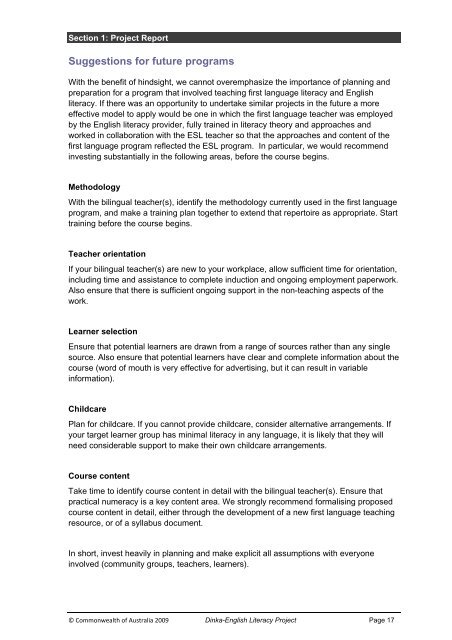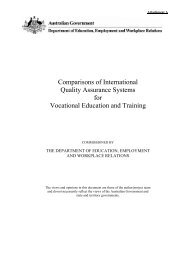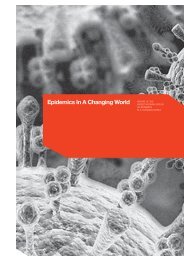First Language (Dinka) Literacy as a Foundation for English ...
First Language (Dinka) Literacy as a Foundation for English ...
First Language (Dinka) Literacy as a Foundation for English ...
Create successful ePaper yourself
Turn your PDF publications into a flip-book with our unique Google optimized e-Paper software.
Section 1: Project Report<br />
Suggestions <strong>for</strong> future programs<br />
With the benefit of hindsight, we cannot overemph<strong>as</strong>ize the importance of planning and<br />
preparation <strong>for</strong> a program that involved teaching first language literacy and <strong>English</strong><br />
literacy. If there w<strong>as</strong> an opportunity to undertake similar projects in the future a more<br />
effective model to apply would be one in which the first language teacher w<strong>as</strong> employed<br />
by the <strong>English</strong> literacy provider, fully trained in literacy theory and approaches and<br />
worked in collaboration with the ESL teacher so that the approaches and content of the<br />
first language program reflected the ESL program. In particular, we would recommend<br />
investing substantially in the following are<strong>as</strong>, be<strong>for</strong>e the course begins.<br />
Methodology<br />
With the bilingual teacher(s), identify the methodology currently used in the first language<br />
program, and make a training plan together to extend that repertoire <strong>as</strong> appropriate. Start<br />
training be<strong>for</strong>e the course begins.<br />
Teacher orientation<br />
If your bilingual teacher(s) are new to your workplace, allow sufficient time <strong>for</strong> orientation,<br />
including time and <strong>as</strong>sistance to complete induction and ongoing employment paperwork.<br />
Also ensure that there is sufficient ongoing support in the non-teaching <strong>as</strong>pects of the<br />
work.<br />
Learner selection<br />
Ensure that potential learners are drawn from a range of sources rather than any single<br />
source. Also ensure that potential learners have clear and complete in<strong>for</strong>mation about the<br />
course (word of mouth is very effective <strong>for</strong> advertising, but it can result in variable<br />
in<strong>for</strong>mation).<br />
Childcare<br />
Plan <strong>for</strong> childcare. If you cannot provide childcare, consider alternative arrangements. If<br />
your target learner group h<strong>as</strong> minimal literacy in any language, it is likely that they will<br />
need considerable support to make their own childcare arrangements.<br />
Course content<br />
Take time to identify course content in detail with the bilingual teacher(s). Ensure that<br />
practical numeracy is a key content area. We strongly recommend <strong>for</strong>malising proposed<br />
course content in detail, either through the development of a new first language teaching<br />
resource, or of a syllabus document.<br />
In short, invest heavily in planning and make explicit all <strong>as</strong>sumptions with everyone<br />
involved (community groups, teachers, learners).<br />
© Commonwealth of Australia 2009 <strong>Dinka</strong>-<strong>English</strong> <strong>Literacy</strong> Project Page 17
















